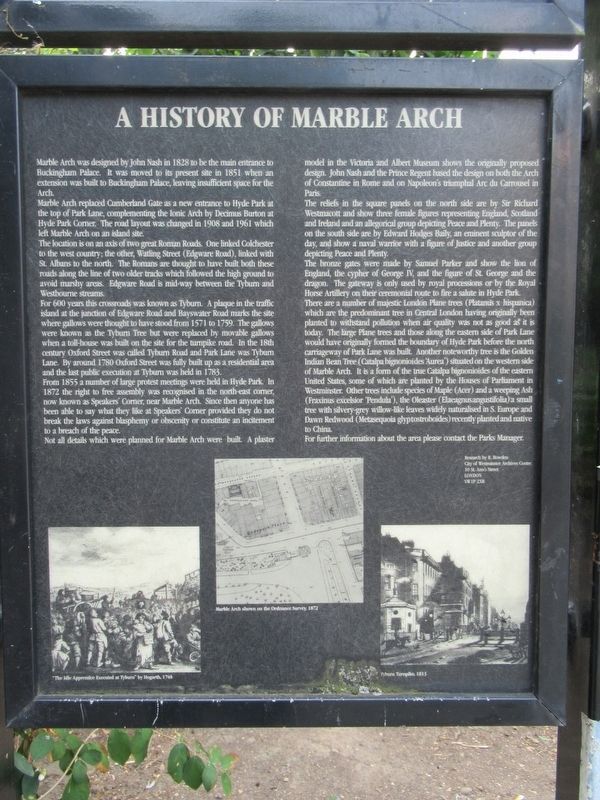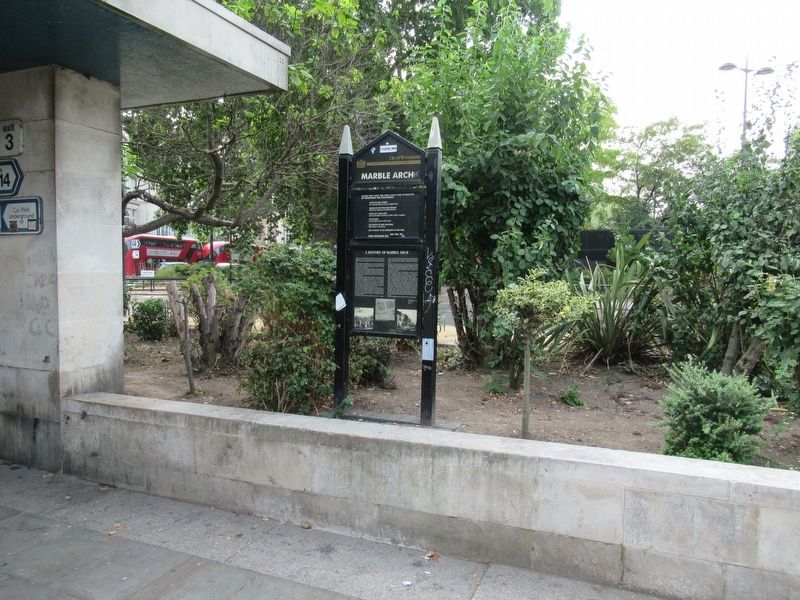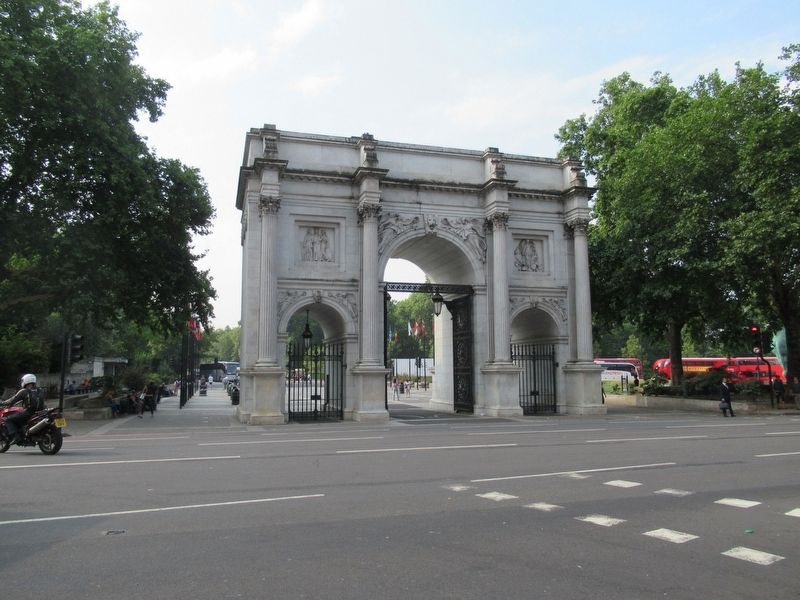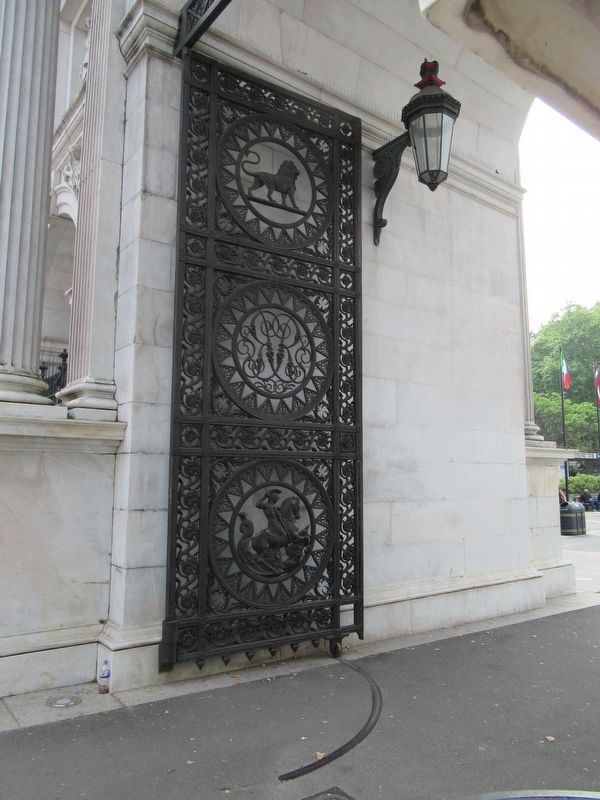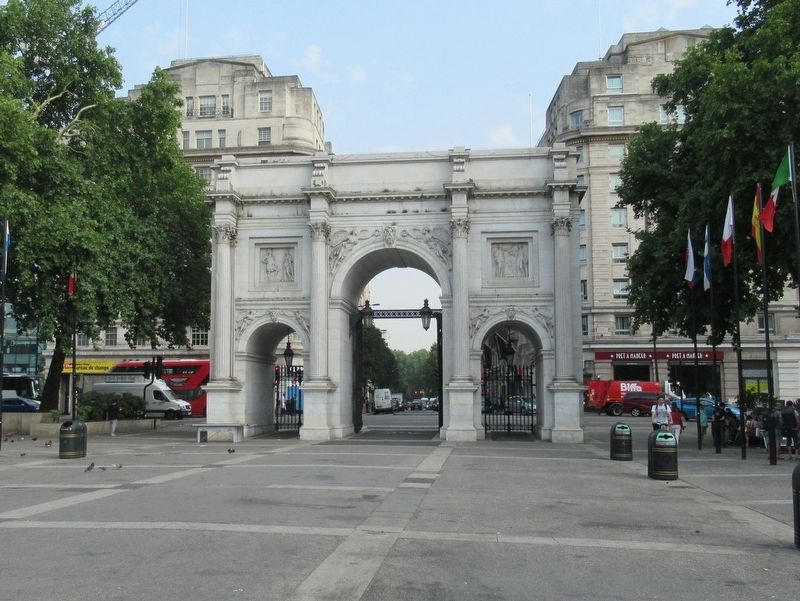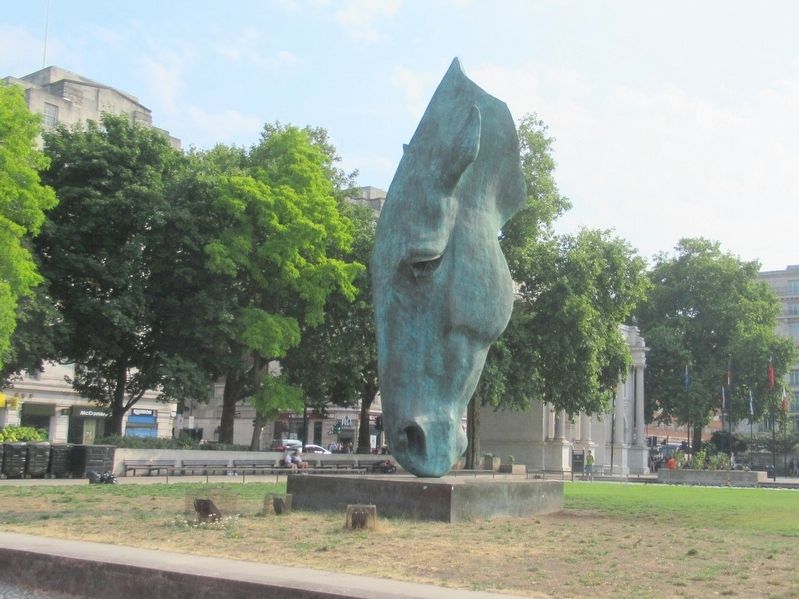City of Westminster in Greater London, England, United Kingdom — Northwestern Europe (the British Isles)
A History of Marble Arch
Marble Arch was designed by John Nash in 1828 to be the main entrance to Buckingham Palace. It was moved to its present site in 1851 when an extension was built to Buckingham Palace, leaving insufficient space for the Arch.
Marble Arch replaced Cumberland Gate as a new entrance to Hyde Park at the top of Park Lane, complementing the Ionic Arch by Decimus Burton at Hyde Park Corner. The road layout was changed in 1908 and 1961 which left Marble Arch on an island site. The location is on an axis of two great Roman Roads. One linked Colchester to the west country; the other, Watling Street ( Edgware Road), linked with St. Albans to the north. The Romans are thought to have built both these roads along the line of two older tracks which followed the high ground to avoid marshy areas. Edgware Road is mid-way between the Tyburn and Westbourne streams.
For 600 years this crossroads was known as Tyburn. A plaque in the traffic island at the junction of Edgware Road and Bayswater Road marks the site where gallows were thought to have stood from 1571 to 1759. The gallows were known as the Tyburn Tree but were replaced by movable gallows when a toll-house was built on the site for the turnpike road. In the 18th century Oxford Street was called Tyburn Road and Park Lane was Tyburn Lane. By around 1780 Oxford Street was fully built up as a residential area and the last public execution at Tyburn was held in 1783.
From 1855 a number of large protest meetings were held in Hyde Park. In 1872 the right to free assembly was recognised in the north-east corner now known as Speakers Corner, near Marble Arch. Since then anyone has been able to say what they like at Speakers Corner provided they do not break the laws against blasphemy or obscenity or constitute an incitement to a breach of the peace.
Not all details which were planned for Marble Arch were built. A plaster model in the Victoria and Albert Museum shows the originally proposed design. John Nash and the Prince Regent based the design on both the Arch of Constantine in Rome and on Napoleon's triumphal Arc du Carrousel in Paris.
The reliefs in the square panels on the north side are by Sir Richard Westmacott and show three female figures representing England, Scotland and Ireland and an allegorical group depicting Peace and Plenty. The panels on the south side are by Edward Hodges Baily, an eminent sculptor of the day, and show a naval warrior with a figure of Justice and another group depicting Peace and Plenty.
The bronze gates were made by Samuel Parker and show the lion of England, the cypher of George IV, and the figure of St. George and the dragon. The gateway is only used by royal processions or by the Royal Horse Artillery on their ceremonial route to fire a salute in Hyde Park.
There are a number of majestic London Plane trees (Platanus x hispanica) which are the predominant tree in Central London having originally been planted to withstand pollution when air quality was not as good as it is today. The large Plane trees and those along the eastern side of Park Lane would have originally formed the boundary of Hyde Park before the north carriageway of Park Lane was built. Another noteworthy tree is the Golden Indian Bean Tree (Catalpa bignonioides ‘Aurea’) situated on the western side of Marble Arch. It is a form of the true Catalpa bignonioides of the eastern United States, some of which are planted by the Houses of Parliament in Westminster. Other trees include species of Maple (Acer) and a weeping Ash (Fraxinus excelsior ‘Pendula’), the Oleaster (Elaeagnusangustifolia) a small tree with silvery-grey willow-like leaves widely naturalised in S. Europe and Dawn Redwood (Metasequoia glyptostroboides) recently planted and native to China. For further information about the area please contact the Parks Manager.
Topics. This historical marker is listed in this topic list: Notable Buildings.
Location. 51° 30.77′ N, 0° 9.512′ W. Marker is in City of Westminster, England, in Greater London. Marker is at the intersection of Park Lane and Cumberland Gate, on the left when traveling north on Park Lane. Touch for map. Marker is in this post office area: City of Westminster, England W1C 1LX, United Kingdom. Touch for directions.
Other nearby markers. At least 8 other markers are within walking distance of this marker. Animals In War (about 210 meters away, measured in a direct line); Leo Bonn (about 240 meters away); George Seferis (approx. 0.3 kilometers away); Benjamin Disraeli (approx. 0.4 kilometers away); Dwight David Eisenhower (approx. 0.4 kilometers away); Sir Frederick Handley Page (approx. 0.4 kilometers away); Lord Milner (approx. 0.6 kilometers away); Simón Bolívar (approx. 0.6 kilometers away). Touch for a list and map of all markers in City of Westminster.
Also see . . . Marble Arch on Wikipedia. (Submitted on August 9, 2018, by Michael Herrick of Southbury, Connecticut.)
Credits. This page was last revised on February 1, 2024. It was originally submitted on August 9, 2018, by Michael Herrick of Southbury, Connecticut. This page has been viewed 201 times since then and 22 times this year. Photos: 1, 2, 3, 4, 5, 6. submitted on August 9, 2018, by Michael Herrick of Southbury, Connecticut.
